#edwardian-style architecture
Text

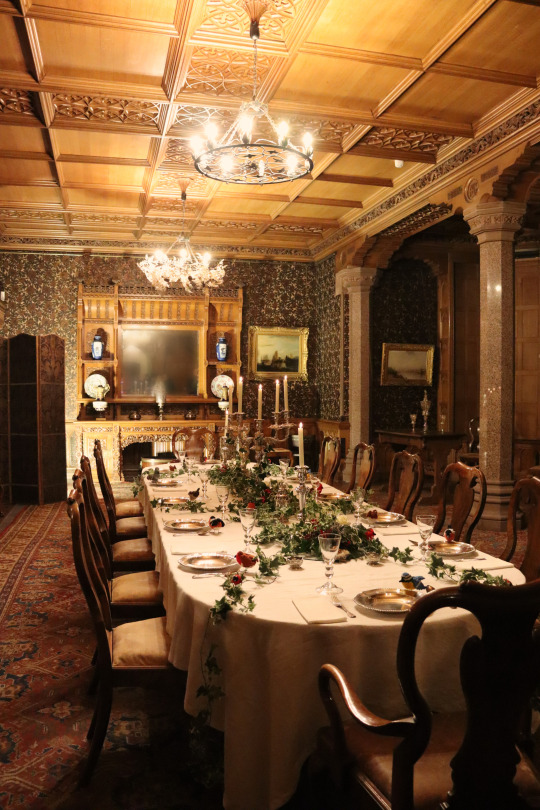




Victorian Christmas at Tyntesfield 🎄
#cottagecore#cottage core#cottage aesthetic#victorian#victorian era#edwardian#antique#1890s#1800s#tyntesfield#victorian aesthetic#victorian architecture#late 1800s#victorian age#19th century#christmas#christmas aesthetic#vintage#vintage style#dark academia#dark acadamia aesthetic#dark academism#art#architecture#victorian art#aesthetics#fairmaidnelly
785 notes
·
View notes
Text

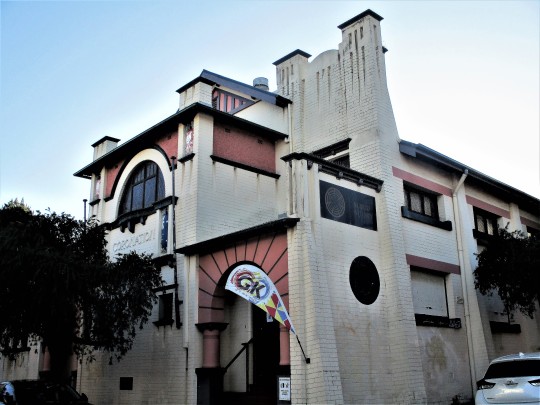
Coronation Hall (1911). A rather odd former church hall in the short lived "Arts & Crafts Style", commemorating the coronation of King George V. Originally the church hall for St. Enoch's Presbyterian Church (1865), which has long since been demolished to make way for housing. Now a privately owned hall-for-hire. Heritage Listed. Newtown.
#vintage#old church hall#heritage#arts & crafts style#edwardian era architecture#streetscape#facade#odd#survivor#coronation#it's a sign#hall for hire#george V#early 20th century#inner west sydney
74 notes
·
View notes
Text

McLean Institute, Christchurch, New Zealand (1900s)
Built in a Jacobean style between 1899 and 1900 from Aotearoa (New Zealand) native timber Kauri, McLean Institute, originally known as 'Holly Lea' (later McLean's Mansion) is one of the biggest wooden residentail buildings in the world, and was the biggest residential building in New Zealand at the time of it's construction. Commissioned by Allan McLean, a scottish philanthropist, the building is now a category one historical building, despite sustaining a fair bit of damage in the Christchurch Earthquakes, she still stands to this day but is looking for a new owner who will hopefully restore her to her former glory.
This personally is my favourite building I've encountered and I hold dear in my heart, I really hope for her to be claimed by someone soon before the perils of time ruin her beyond repair.
It's been 13 years now since the most devistating of the series of earthquakes we had in Otautahi (Christchurch), where she has since stood boarded up behind a big metal fence over the past decade and a bit.
#my archive finds#Holly Lea#McLean Institute#McLeans Mansion#Christchurch#Otautahi#Canterbury#New Zealand#Aotearoa#History#New Zealand History#Allan McLean#Jacobean#Jacobean Style#Jacobean Architecture#Edwardian#Edwardian era#Edwardian Building#Edwardian mansion#photography#1900s
3 notes
·
View notes
Text

#cottagecore#grandmacore#victorian home#victorian architecture#victorian style#victorian homes#victorian era#victorian#edwardian#port townsend#pnw#pnwonderland#pnwcore#washington state
16 notes
·
View notes
Text

Streets in San Francisco, California
Made famous in such movies as Mrs. Doubtfire (1993) and television shows like Full House (1987-1995), a row of houses on Steiner Street near Alamo Square in San Francisco have become a historic landmark, attracting thousands of tourists each year. The Victorian and Edwardian-styled homes are beautifully painted in various pastel colors.
#pics from pinterest#streets in#san francisco#california#usa#streets#street scene#street photography#street art#streetview#street shot#architecture#architectural styles#edwardian#victorian#house#home#pastel#colors#colorful city
6 notes
·
View notes
Text

Here's a 1990 Edwardian style home that is a little over-decorated in Greenwich, Connecticut. 9bds, 8ba, 2.5ba - $6.5M (5.64 acres)

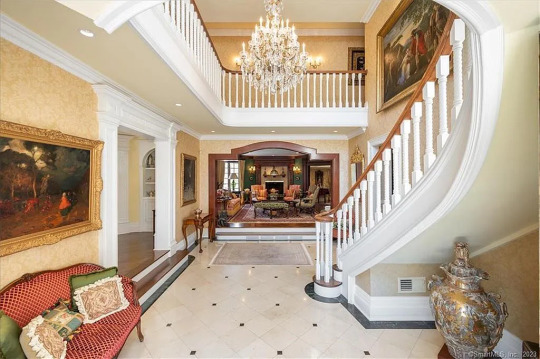
The grand entrance has an architectural feature of 2 steps going up into the sitting rooms, while the other rooms do not.

Very large sitting room filled with furniture.

Also a very large dining room with a deeply coffered ceiling. I feel that there are too many patterns.
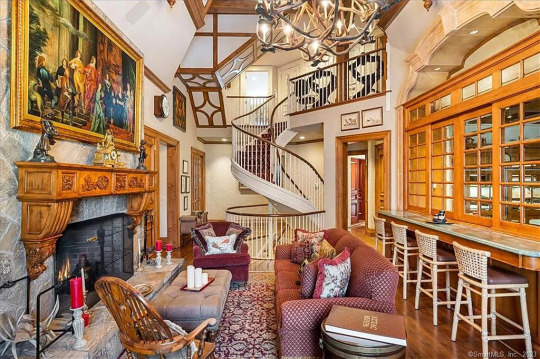
The family room. There's much going on in here. A spiral staircase that turns into regular stairs- look at the decorative feature under the stairs. The counter with the windows is the kitchen.

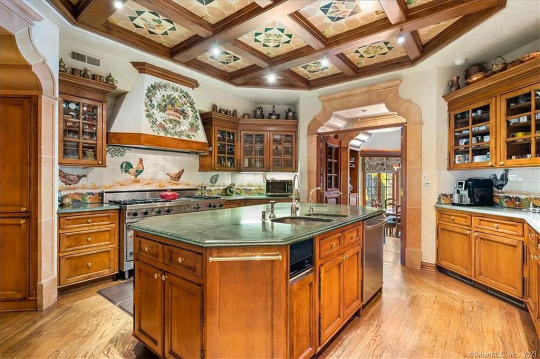
Check out the ceiling- it looks like a quilt. Roosters adorn the backsplash and there's even a painting on the exhaust hood.

Thru this passageway of cabinetry is the everyday dining room.

Huge double sitting room. Check out the columns.

Here's a very distinguished home office. I guess you would need one to afford a home like this.

Even this hallway is decorated.

Here's a guest powder room with a feature just for the toilet.

Massive primary bedroom. Look at the size of that headboard- it almost touches the ceiling.

The primary bath features a jetted soaker tub set into a custom surround.
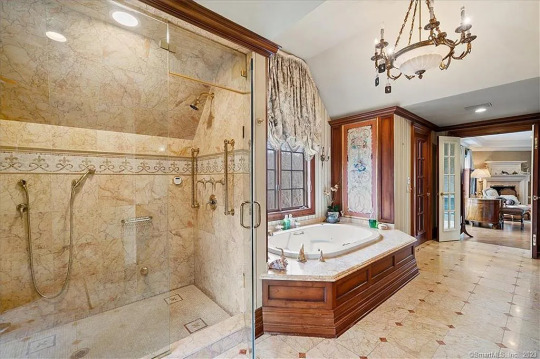
Look at how big the shower is.

Here is another office that looks like it may belong to a house manager. (I recently learned that very wealthy people have house managers that hire the nanny, supervise the cleaning staff and basically run the household.)
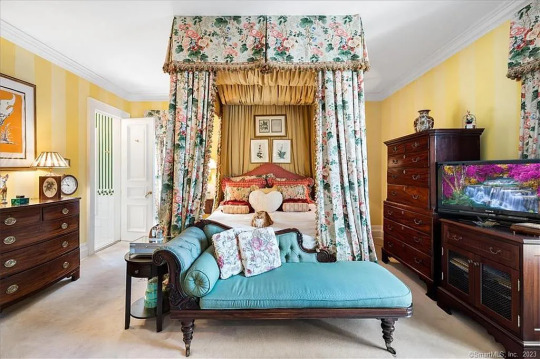
One of the secondary bedrooms. Look at all the fabric on that bed.

This is a nice bath. I like the tile in the tub.

Another home office.

Cute nautical bath. I love the tub.
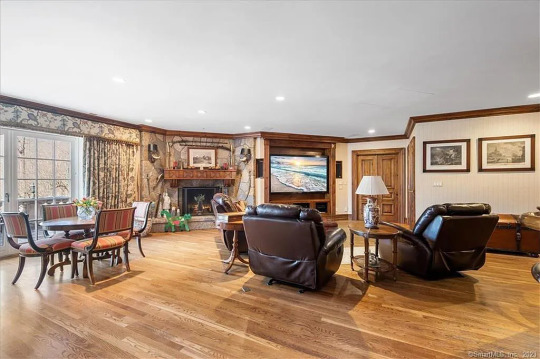
The upstairs family room has a gaming table, fireplace, comfy TV chairs, and lots of space.

And, we have a rec room with a bar, pool table and wine cellar.
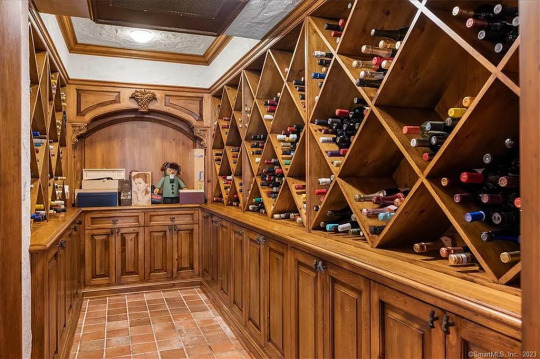
The wine cellar.
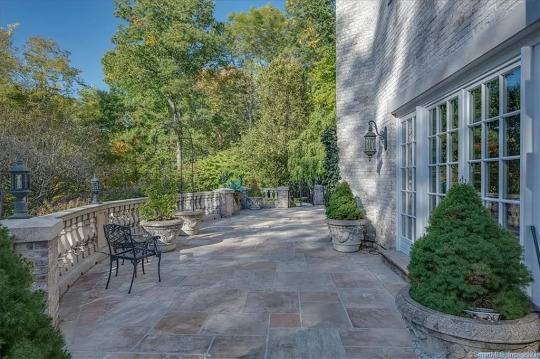
Large terrace.
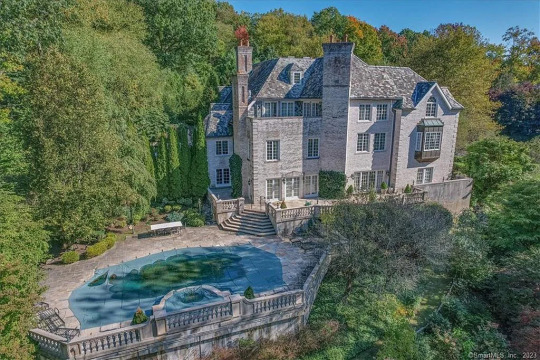
The terrace goes down to the patio and pool area.

Very large home, isn't it? There seems to also be a rooftop deck.
https://www.zillow.com/homedetails/93-Porchuck-Rd-Greenwich-CT-06831/240523947_zpid/
113 notes
·
View notes
Text

I don't know about you guys... but I'm tired of winter. I think it's time to do a little spring cleaning in my house. The ins and outs, the ups and downs.... wait, what was I talking about?
Right! It's time for our next task!
While you're spring cleaning, or bribing a Brownie to do the cleaning for you (We recommend Sweeping Beauty Brownies on the South end of town), we would love to know more about where each of our residents call home!
This is a creative task, so you are welcome to do this in any way you see fit. You can provide us with a mood board, a pinterest board, a self para with a descriptive walk through, a sims walk through video tour, the possibilities are endless. We just want to know where your muse lives, and want to see that you've put in some effort.
There are some important elements that are needed to be included, please click the read more for your complete instructions.
IMPORTANT: If your character lives with other characters, everyone in the house must have input on this task. I would prefer if everyone in the house made a post of some sort related to the task. I recommend collaborative pinterest boards to discuss thoughts with pictures more easily, but the way you do this is up to you.
Now, for the criteria that we require:
First, please choose a district for your character to live in and make sure that that's clearly labeled. If you need a remider of the districts:
To the north of town will be more modern homes and our more upscale shopping. meraki station is located here, so if you plan to travel frequently, you should accustom yourself with this area.
to the east, we have a more victorian and edwardian style residential area along with smaller shops and a cozy down town area.
to the west, we have mid century architecture, along with many dining and communal areas.
to the south, we have lower income housing, apartments, townhouses, etc… along with a rich natural area. please be wary of the forest and the waters in this area after dark. cryptids aren’t cryptic in the safety of evergreen.
Second, I know that asking for a whole house is a lot, but I do expect to see at least the main rooms, and one area that means something to your character (ie. kitchen, living room, and bedroom for your main rooms, then show me an office or some sort of personalized area in one of those rooms for the bare minimum - what makes your character's house a home?).
Anything you add beyond that is up to you, but I really want to see you guys put some work into this. Show me who your character is, what they collect, what their comfort area is like. Show me where they wind down after a hard day. The level of detail you put into this is up to you, but the more you give, the more character development you get to work on and we all love that.
This task is due by 11:59pm on March 8th!!!
Anyone who completes this task will get a special benefit when our Renaissance Faire comes to town in a little while
....who said that?

14 notes
·
View notes
Note
Heyo just wondering if there are any physical descriptions of the rulers for marriage of state au? (there could have been some I have read before just can't remember) I know it is based off empires so the skins are prob somewhat relevant but the skins can be interpreted in many different ways. So I guess my actual question is, what does everyone wear??? Are chemises and stays common in some places? Do some empires wear a bunch of layers like the Edwardian and Victorian styles or are they like some specific cultural dress of somewhere? are some empires wearing an un-holy mash of a bunch of different styles? Hoop skirts and crinolines? (how do u spell that stupid word??? ;-;) I know you went into what empires wear is made out of but what garments are said textiles made into?
So I've made a few character design focused posts so far. Specifically, Joel and the Seablings so far. I'm in the process of writing Xornoth's. (I randomly generated the order for them because I am indecisive XD) They have their own section on the masterpost as it currently exists and will be one of the things I keep directly linked on the revised version when I get around to that.
On a general note, "what everyone wears" varies fairly wildly from empire to empire. My costuming decisions draw about equally from the skins and the architecture styles (e.g. greco-roman influences in the ocean empire combining with fantasy coture, Rivendell combines visual elements from the lotr movies with a viking-era Scandinavian influence, Byzantine layers and accessories in Mezalea, etc...)
chemises and stays are one of the varieties of undergarments that can be found, but very much older versions. Most of my influences are high/fallen fantasy and ancient civilizations through about mid-medieval Europe. So no hoop skirts or crinolines.
I'll save more of the specifics because if I type it all up here I'll be even slower about making the actual official character-specific posts
Edit:
There is also Official Art. So far just the Seablings. It’s linked on their posts
#ask and it shall be answered#justafeweggnoodles#marriage of state au#rain rambles#i am not a historical costumer myself#but i am close with several of them#so ive picked a lot up via osmosis#mos: asks
14 notes
·
View notes
Note
Why did the early-mid century culture hate the victorians so much? Was it just "my grandparents lived through it so I associate growing up around this stuff with being outdated and yucky" kinda like how I've seen the 1970s-80s regarded? Or was there something else going on there culturally?
I suspect it's partially that, and partially just. How much everything changed aesthetically in a relatively short span of time.
I mean, if you look at the feminine fashion differences between 1860 and 1880, the trim and silhouette obviously differ greatly but the basic composition of the outfit is the same. Same under-layers, same general bodice-and-skirt format for most dresses, same hemlines, same broad expectation for the hair (long, mostly one-length, natural colors) even though the popular styling of women's updos changed.
and then you look at, say, 1905- Edwardian, but that same general outfit format -to 1925.

(Le Costume Moderne, 1905.)

(The Delineator, 1925.)
There had been radical aesthetic shifts over relatively short periods before- see also: 1780 vs. 1800 -but to my knowledge few of them involved changing the composition of outfits so radically. The 1920s saw the beginning of the now-familiar bra and panties model of conventionally feminine undergarments, for example, as opposed to the immediately prior "chemise and drawers, or combinations, and corset" model. In a very real way, that decade seems to me to have introduced the way we wear clothing today. Obviously some things like girdles and slips have mostly fallen by the wayside, but. It's the beginning of a clothing system that seems vastly more familiar to most of us now than what came before. And with that shift came a lack of understanding of how the earlier model actually worked in everyday life. Combined with new strides being made in women's rights compared to the previous status quo, it could be all too easy to see such totally foreign fashions as awkward and oppressive.
Also it was very much a time that emphasized all things new and exciting, as humans are often wont to do. So the past, and all it represented, cut very little ice. Especially the relatively recent past.
I mean, look at Art Deco and Midcentury Modern. They're basically the polar opposite of Victorian styles that emphasize heavy ornamentation, natural materials, maximalist decor, organic lines, historical inspiration, etc. It's not hard to see that someone raised in that environment might look on the very alien houses- and clothing -of the past and recoil a bit.
And yeah, I think there may have been a bit of a Granny Effect going on- something you grew up associating with fusty old people is bound to have less romance than something you've no direct connection to. Indeed, we do see a bit of Colonial Revival architecture popping up in the 1940s-50s U.S., suggesting that it wasn't necessarily the past as a whole that people of the early-mid 1900s objected to.
(Also, you do occasionally get bits of Victorian nostalgia. Often in the form of art depicting earlier times with varying degrees of accuracy, dolls costumed in past styles ditto, movies set in the mid-late 19th century, recommendations about how to make one or two bits of Victorian furniture into "quaint" statement pieces for a room, etc. Still, it's often a general damnation with faint praise.)
So those are my rough thoughts on the subject!
122 notes
·
View notes
Text

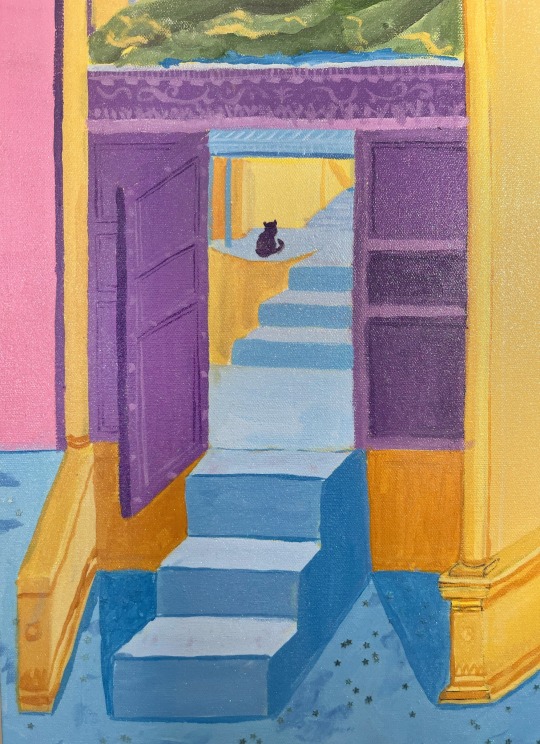




Midnight Secrets, acrylic on canvas, 72x60 inches, 2023.
Drawing inspiration from the rich mythology of San Francisco, I have incorporated elements of landscape, architecture, and still life, using Pompeii wall paintings as a foundation. The Tenderloin, with its diverse blend of architectural styles—Renaissance, Baroque, Victorian, Edwardian, and Art Deco—creates a visually captivating backdrop that reflects the neighborhood's fusion of past and present. It is also a place of historical significance, being home to the world's first transgender district and the site of the 1966 Compton's Riot, a seminal moment in the LGBTQ+ movement.
To amplify the narrative of my work and embrace my queerness and connection to San Francisco, I have departed from the traditional natural pigments used by the Romans. Instead, I incorporate pigments that reflect my identity and experiences. The vibrant "pinkest pink" pigment, gifted to me by a close friend, represents my boldness and authenticity. Pastel shades, hold a special place in my artistic repertoire, evoking a sense of joy and nostalgia. I employ copious amounts of iridescent micro diamonds, which remain hidden until one approaches the artwork closely, unveiling an explosion of color and enchantment.
Through my art, I aim to capture the essence of love, community, and personal expression. It is my fervent desire to scream my loves into the night, and in doing so, create a visual love letter to the neighborhood I call home. By intertwining the ancient echoes of Pompeii with the modern tapestry of San Francisco, I strive to convey a sense of understanding, resilience, and the enduring spirit of a vibrant community that celebrates diversity and embraces its history, even in the face of adversity.
#art#artists on tumblr#san francisco#painting#sf#work#acrylic#e dyer#de young#de young museum#pompeii
21 notes
·
View notes
Text


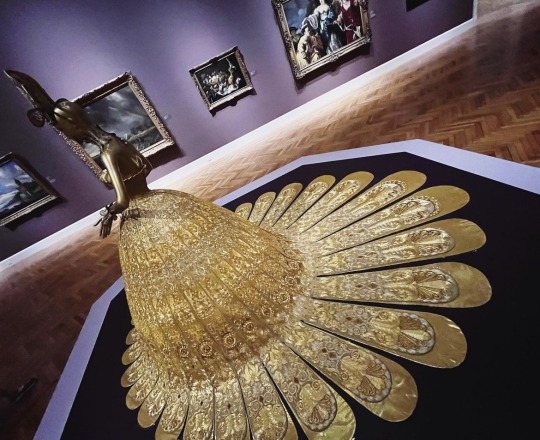

San Francisco's Legion of Honneur museum offers a dazzling selection of Guo Pei’s magnificent haute couture gowns created from 2006 to the present. Considered to be the first Chinese haute couturier, Guo Pei grew up during the Chinese Cultural Revolution, a tumultuous period where anything belonging to China’s Imperial past - traditions, script, literature, arts and antiquities, family histories and property - were all forbidden or destroyed. With an inexhaustible vocabulary of traditional motifs (lotus, Buddha, dragon, lilies, peacocks) woven onto sumptuous gold thread, “Guo Pei creates a fantasy that fuses the influences of China’s imperial past, decorative arts, European architecture, and the botanical world.” As imposing as the garments are, they also seem to poke fun at the spiritual and cultural weight of couture and Chinese traditional values. In several of her architecture series pieces, she uses bamboo strips, a material usually used as throwaway building scaffolding, in constructing Edwardian-style hoop skirts with boned corsets. In another couple of pieces from the same collection, she references Gothic cathedrals in monochrome embroidery on silk gauze: One can see pointed arches, flying buttresses, and stained glass sections placed where the wearer’s chest would be. Formerly reserved by law for the royal court, yellow silk dragons make their appearance time and again over gowns, deconstructed epaulets, even chaps held up by gold ribbons.
7 notes
·
View notes
Text
Get To Know Me
I was tagged by @ladyinthebluebox, @ainulindaelynn, @brasideios, and @krankittoeleven. Wow, y'all! it was an honor to be tagged so much! Sorry it took me a few days to finish typing this up.
Last Song: If I Could Give you More- Harry Connick Jr. My partner was talking about the jazz music she likes so I was reminded of the music I used to listen to. I really liked this cd as a kid (I stole it from my mom) so I'm listening to it again.
Favourite Colour: Pthalo blue
Currently Watching: I was at my mom's so we were watching 'Miss Scarlet and the Duke'. It's ok. Fascinated by the clothing, my mom and I couldn't stop remarking about the collars. She didn't know about men's detachable collars. Also those walking suits?! Ma'am, you have so many pleats going on. I'd hate to have to iron those outfits. I'd hate to iron in general.
Last Movie/TV show: The Brothers Sun! Charles <3 <3 <3 <3 pls I love you, pls get some therapy. You can bake a cake after as a treat.
Spicy/Savoury/Sweet: I'll usually choose savory. Spicy and Sweet have a higher chance of being a disappointment. Savory is the safe choice.
Relationship Status: Stumbled into a relationship.
Current Obsession: The Sims 4 put out a new expansion where you can properly build apartment houses and I've been going nuts trying new things, trying to recreate different styles of architecture. Stuck on Arts and Crafts style bungalows again, but the Queen Anne style is creeping in on my Newcrest rebuild and I don't know how I feel about that. Still can't build jerkinhead roofs, which makes me really sad.
Also Charles Sun.
Also The Long Dark. I'm gonna go moose hunting again and almost die. Again.
Last Google search: What are Victorian/Edwardian shirtbands used for. Still have not discovered the reasoning. Kinda hot though?
tagging @alethiometry, @whereforartthoumisthios, @artschoolglasses, @leofrith, whoever else would like to do this.
6 notes
·
View notes
Text

Remnant single-fronted cottage in the "Federation style". Now rare, only a few of these left standing. Marrickville.
#tiny house#cottage#vintage#early 20th century#federation style#edwardian era architecture#1901-1914#it's a sign#streetscape#facade#rare#survivor#inner west sydney
70 notes
·
View notes
Text
The modern girl of the early 20th century
In this article, we are going to discuss the way in which art, comics and illustrations in the early years of the 20th century helped shape and cement the archetype of the new modern woman, not only in the western world but globally. After all, modernity happened everywhere. I don’t like to put countries and rank them as one set of countries as being the end goal that everyone else is trying to catch up to, because this is very much a tenet of imperialism and i am decidedly not here for it. However, there is no going around how this is part of a very prevalent narrative. That you can quantify progress and quote unquote civilization and modernity. I think of the prevalent idea about of how progress moves and how it’s a view that is generally associated with the current capitalistic understand of our world that values constant progress and growth, and that history works in that manner. However progress is never truly linear, and the way history evolves is full of ebbs and flows, of progress in certain areas, and regression in others, and there is always a judgement of value that is being made when thinking about the march of progress . The 1920s and the 1930s were an era of constant change on all fronts, and the world as a whole was marching straight into the modern world as the repercussions of the first world war were still being felt.
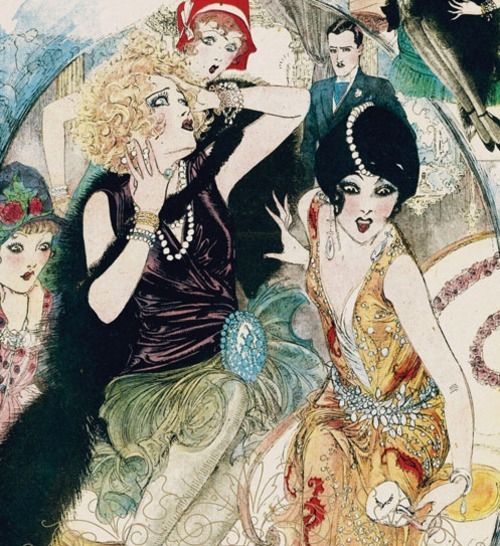
In those years, the printed medium was at its peak, illustrated strips, which were what we would consider to be the ancestor of the comic were gracing the pages of newspapers , and in an age with no internet, where the medium of radio or movies were just getting their start, newspapers were the main way people got all of their informations on the current events, the latest plays and the latest books and all of the knowledge about the right places to be if you were anyone. From the classified ads to the marriage announcements, the newspaper and the printed medium in general was solidly embedded in the culture.
The 1920s and the 1930s were the beginning of the movement of art deco, a new modern style that was clean and streamlined visually, with very neat and geometrical lines, and it is very much a reflection of the current trends in fashion, architecture and design. It is very much in the spirit of the times and i think it was very much in keeping with the times where there was much more of a monoculture in general, you could easily pinpoint what were the big lines of the trends of the eras as they all played off each other and reflected the world that existed around them — through the visual arts, art and culture. There was a generalized aesthetic, if one can say it like that, in a way that I don't think we have anymore. I mean i have been trying to pinpoint what are the trends for the 2020s and when I tell you I absolutely cannot. I have to admit that trends are cycling at such a fast rate nowadays that they do not really have the time to truly permeate the general mainstream culture. On one hand, I do think it’s good that no one can feel the pressure to ascribe to a specific mainstream set of trends if they don’t like to, I think it’s way better to really be able to pick and choose what kind of style truly reflects the person you are and your interests, however I think this does imply a minimum of effort to truly try and discover those interests and curate a personal style and not follow the extremely fast trends that we have now. While before, those trends shifted on a cycle of roughly 10 years, and no matter how stark the transition from the 1910s and the Edwardian era to the shapeless and shorter dresses of the 1920s and then to the more feminine and elegant silhouette of the 1930s, the truth is that the change is very gradual, the shape relaxed and shortened season after season, and it’s only with distance that you can perceive how strong the change was. I think so much of it is in hindsight. Maybe in 10 or 20 years I will be able to pinpoint the changes and broad line of the 2020s tendencies, because history aways seems clearer when you are removed from it.
Through art, images, fashion and advertisement, the world saw a changing and mutating definition and significance off what it meant to be a woman. First of all, I think I really have to stress that i’m talking in binary terms here because this is how the illustrations and advertising as well the shifting of the gender politics were at their base core. I totally acknowledge how it is so much more complicated than that, and the definitions of womanhood and femininity are as diverse and complex and Complicated as there are women in the world, and that our relationship to gender and gender expression is an ever evolving one and that understanding will always be within a certain societal context and you cannot divorce that understanding from the global realities. All of it is arbitrary in a certain way, but it is constructed with social interaction, customs, and visual images contribute greatly to this understanding that we have of it. I will be taking about a very mainstream view of gender, and womanhood here through advertisements and images, which is how that identity was constructed during the period we’re talking about, and especially during the interwar period which was one of great change and shaking up the old ways of how things were being done and how people reacted to it, as well as how it translated to the world of visual culture specifically in the area of the illustrations and comics that were in the printed press and the advertisements of the era.
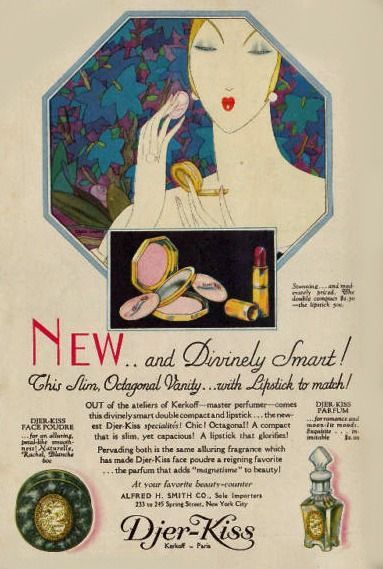
During the 1920s, we can see that change very quickly and assist to a boom in consumerism, with the roaring twenties, the end of the first world war and the end of a very specific idea of traditionalism, there is this new and unbridled world of possibilities in the general culture and consciousness. The youth goes out to try and have fun, the magazines and stores are trying to sell anything and everything to a new modern young woman. The 1920s is the moment where we can see that shift, it’s that clinching moment where things become overwhelmingly mass produced and the predominance of the ready made. Not that this shift was not happening beforehand, the industrial revolution happened in the 1830s or so and it steadily continued during the 19th century, building over what was existing, and changing the cultural mores and the habits around consumption, but i think that break in the 1920s is absolutely obvious. It is the beginning of modernity as one calls it.
With the advent of modernity came new possibilities and understandings. Of course, this phenomenon doesn’t decline itself the same way everywhere in the world, the context in India will be very different from the society in Japan or in the United Kingdom or in France, however, it is possible to see a significant shift in the understanding of the concept in itself of womanhood, and this happened throughout the whole world. In a matter of a couple of decades, the way a woman existed had shifted to something new, exciting, and even a bit scary to those from an older generation holding on to their own definition of what a woman should be. It was the age of the flapper, a word that came to designate this very specific archetype of independent young women of the 1920s.
The early 20th century was an era that was moving extremely fast in terms of the illustrated press. From articles and illustrated strips to publicity, the image was more present than ever before. During the last season of the podcast, I talked about the Golden Age of Illustrations which was from the 1870s to the 1920s, and the reason for this truly that it was the last years before the use of photography and video truly took over the use of illustration in the mainstream for entertainment and advertisement.
These were also the years where cinema was making its way, the silent era, the beginning of the way we think about celebrity. It truly changed the game in a way no one could have predicted. It was an age of glamour and excess. The early years of the film industry were absolutely insane, and please tell me on twitter or instagram if you would like a more in-depth foray into that subject and more precisely into the visuals, the art directing and the way the movies of that time looked, but suffice it to say that it was absolutely bonkers, Hollywood was so unhinged. There was glamour, beauty, but also murder and scandals and sin, and all of it being filmed in a soft focus of satin and sin. Even back then, as Hollywood’s myth and legend was being constructed, it was a place where you could gain it all, or you could lose it all, it had the appearance of perfection, and yet, everyone talked about how it was a den of sin and vices. And I will say that the current Hollywood does not compare at all to those golden years, and especially not when you think of it in terms of the dream that Hollywood sells. All of the current players in the Hollywood scene bore me to tears, I am not enchanted by people trying their best to be hashtag relatable in their gigantic mansions and white tees and cargo shirts. I genuinely think that if you are rich, you should at least look the part somewhat, otherwise what is the point of it ? Where are the beautiful glamorous people at ? No one is even doing a scandal the way they used to anymore, it truly is tragic.
Ralph Barton, a popular illustrator of the 1910s and 1920s created his illustrations for the book Gentlemen Prefer Blondes written by Anita Loos in 1925. His art was a beautiful complement to the story and underlined perfectly the fun and comedic story of the way the young women were trying to climb the social ladder. That book was adapted brilliantly later in the 1950s and starred an absolutely brilliant Marilyn Monroe in the titular role of Lorelei Lee, and while the 1950s movie truly captured the heart of the story and made it their own, which just goes to show that an adaptation does not have to be completely faithful to the text to be faithful to the core of the story. But the original book was about the flapper and the gold digger and the new kind of woman that was started to rise in that era She was a social climber, desperate, and yet still fun and irreverent. The illustrations Barton created for this book were fun, fresh and very representative of the energy of that era, where there was a lot of social mobility, and people were making fortunes, looking to make fortunes, or simply losing these fortunes. It was simply an era of social upheaval in a lot of ways. It was in the air du temps.


This era was chock-full of illustrators and talented artists as visual arts was still extremely highly valued in the mainstream, a lot of female illustrators getting their names in the papers and becoming well known for their comic strips and illustration work. The visual of the modern girl or the new woman, both terms being used almost interchangeably and describing the same concept of this new type of women at the dawn of the jazz age was developed by these very artists. She had boldness, charm and a sort of sexual awareness and a fearlessness, with a desire to seize life and all its possibilities. A Sort of nihilism in line with the general sense of dread and celebration that often follows consequential world events, even a bit of a hedonism especially in western countries. After the first world war, a break from the past and toward modernity.
The short bobbed hair, the vamp makeup, the receding hemlines, even though the length of their dresses were still fairly modest by today’s standards, after all, their knees were still covered, it was such a scandalous break from the earlier traditional mode of dress, may it be the western Edwardian dress, or the places where dress was still majorly traditional and cultural outfits. After all, it is because of capitalism, fast fashion and cultural imperialism and globalization that nowadays we are all wearing very similar fashion and dress whether you live in Italy, Nigeria or Peru. Of course, cultural mores will make it be slightly different from place to place, but hoodies, trousers trainers are worn all over he world. However. A bit more than a hundred years ago, people were still wearing their caracos and djellabas in Algiers, and now those outfits are being left for special events. In Korea, Hanboks were worn on a daily basis. In less than a hundred years, most of, if not all, traditional and cultural outfits have been relegated to relics of the past. And yet, the 1920s is that moment where modern western dress started to really become the norm as the world shifted into modernity, and this new scary idea of the modern woman started to take hold.
Beauty and the advertisement of beauty, makeup and fashions were a cornerstone of the way that identity was constructed, because for the first time since the 18th century at least in the western world, the use of visible makeup was no longer frowned upon. I say visible, because even though makeup was thought to be the purview of actresses and ladies of ill-repute in the 19th century and the Edwardian eras, women were still using cosmetic aids to beautify themselves. Of course, it's the ever-present no makeup makeup look that is infinitely more complicated to master than any colorful and ostentatious look could ever wish to be. So at the turn of the 1920s, women were wearing dark lips, in plums and dark reds, and surprisingly bright eyeshadows and rouge, and none of it was made to be discrete and hint to the notion of a natural face. The Modern Woman was painted and made-up, unbalancing the social norms that were established until then. It was a very visible shift from the obsolete and the traditional to the very made-up New Woman, and there is a list of beauty and makeup items and objects that are all absolutely gorgeous I have to say, that are associated with this. It’s the new accessibility of consumerism where it was before limited to the elites, now everyone could purchase eyeshadows and a compact of powder and rouge and those minuscule multipurpose makeup compacts with a tiny lipstick and a bit of rouge and powder and some mascara, so that you could touch up on the go and carry it in the tiny bags that were in fashion. Those items were luxurious and opulent, and fairly affordable comparatively to what they had been previously, especially with the rise of the ready-made.
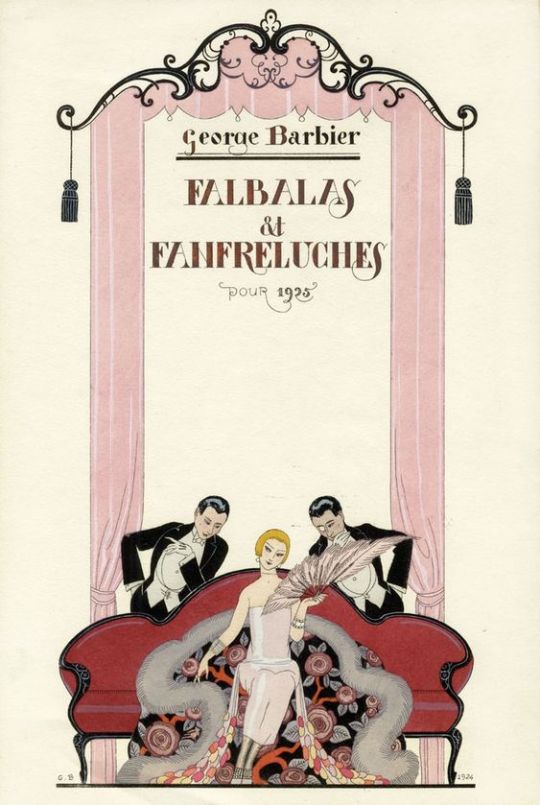
Is consumerism a visual symbol of modernity ? After all, the almost omnipresence of publicity in our visual world, which was definitely the case in the global world in the 1920s, is one of the ways in which that modernity, along with the dominion of capitalism that demands constant consumption from the people. As John Berger says in his foundational art history book Ways of Seeing published in 1972, which btw I totally recommend to get if you want to dive a bit deeper into art history theory, or you can just watch his 4 parts show of the same title which btw and i haven't said anything COULD potentially be on youtube but i haven't said anything at all. Anyway as he says quote : publicity images […| belong to the moment in the sense that they must be continually renewed and made up-to-date. Yet they never speak of the present. Often they refer to the past and always they speak of the future unquote. This was extremely relevant in the world of the interwar, where the construction in itself of the identity of the modern woman was made through those publicity images.
There is also something to be said about how the concept of modernity and of the modern girl truly blurs the lines of a social hierarchy., and that was a good thing, I do think those lines should be blurred to the point of non-existence. Now everyone could look like the popular starlets of the movies and buy their own makeup and clothes that could make them look as glamorous as the women on the silver screen, the easy availability of cosmetics, and of a climate of consumerism made it so that everyone could attain that status, the lines between the social boundaries and between the quote unquote elites and the working class are becoming more fluid than ever. Where the way you dressed immediately signaled your social rank and your place within the hierarchal structure, which, in turn, told other people how to treat you, this was no longer necessarily the case. However as those lines are shifting and moving, the way you could signal your status have also shifted.
The year was 1925 and Nell Brinkley, a young reporter and famous illustrator, was sending the first strips of The Adventures of Miss Prudence Prim out for publication to William Randolph Hearst’s Sunday American Weekly. Her stories of romance, love and carefree amusement were capturing the zeitgeist of this period that was the interwar: these years full of change and when modernity was at the forefront of culture. Born in the small town of Edgewater in Colorado in 1886, Nell Brinkley always had dreams of making art her career. At only 19 years old, after convincing her father that she could earn her life with a short contract as an illustrator at the Denver Post, she finally moved to the city where she would accomplish those dreams : New York. She came of age during the pinnacle of Edwardian sensibilities and was influenced by the ornate curves of Art Nouveau, but also by the new visual ideas of Art Deco. She created a style that was very unique for her time and was a woman who was constantly looking forward to the future. She was a perfect example of the New Woman of the 20th century. A woman that was bold, vibrant and who was not afraid to speak her mind. Her art was a vignette of a time that's now long gone by, and yet her art still feels as charming as it used to be. Those were delightful images of youthful fun and desire, ideas of romance, and, most surprisingly perhaps, issues of women’s rights and the working class.
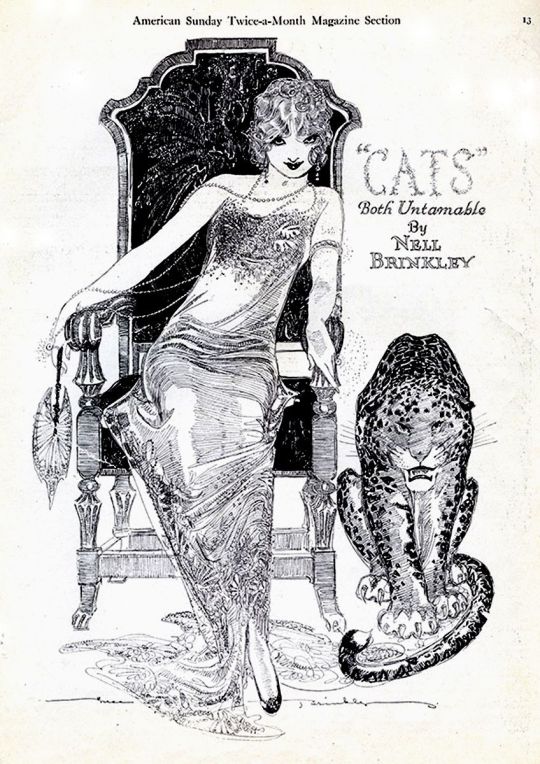
Brinkley got her start and her renown as an illustrator and journalist in 1907, while covering the gruesome and shocking case of Harry K. Thaw, a highly publicized trial involving the beautiful and popular showgirl Evelyn Nesbit. This case was sordid, involving a murder, a jealous husband, and a previous lover of Nesbit, and was a huge news story during that year. Brinkley’s interviews and various portraits of Nesbit put her in the limelight as a talented illustrator and reporter.
Commentator and columnist as well as an artist, the career of Nell Brinkley was prosperous and she was a constructing a new vision of womanhood. She was writing and drawing for women, and they were her direct audience. She wrote about cultural events, reviewed plays, gossiped about the latest fashions and movies. Her columns and her art were a guide to living fully and encouraging women to realize their full potential. Brinkley’s work had a definite feminist slant to it, in favor of working women and pushing for the rights of women. Her cartoons and illustrations had a decidedly political element to them that was part of the spirit of the times, about the endless possibilities that they carried within them. Without necessarily being an activist, she was always pushing for progress and women’s rights and trying to unshackle the constrictions of gender norms that were remnants of a previous generation. She was a writer as well as an illustrator, and this is how she communicated a vision of womanhood that was new and fresh, and she represented the way a lot of young women felt during these years. The New Woman, as she became known, was the face of a modern generation of women.
The archetypes of her illustrations were so strong that they were known as the "Brinkley Girls, » with their head full of short curls, their sleepy eyes and their darkened lips which brought a new vision of femininity. The Brinkley Girl was a break from traditional archetypes of beauty. She was no longer the demure and aloof women drawn by Charles D. Gibson that were in vogue. The Gibson Girl of the Edwardian era, with her long hair, her cold and distant beauty was now a thing of the past. The Brinkley Girls were far from being shy, and were not hesitant to take life as it came, and live fully and wholeheartedly. There was a certain desire of enjoying one’s life that was at the core of the illustrations of Brinkley. Emotion, passion and romance, as well as a sort of carefree independence were the new motto of a new generation of women who wanted to desperately have fun. It was an idealized idea of life and romance that provided a definite appeal to its audience.
The Brinkley Girl archetype was so widespread that it was used for advertising during the 1910s and the 1920s for diverse products that the modern woman would be using in her daily life. She was thus set as a symbol of the eminently modern woman. From hair curlers that « will not break your hair » to henna dye and face powder, the curly haired young women of Nell Brinkley were a good example of how illustration was used as part of advertisement in the early 20th century, blurring the lines between art and capitalism. The Brinkley Girl was known in the cultural sphere as being a symbol of a new generation of young women who were fearless, representing a vision of womanhood that was progressive and a celebration of independence as well as pleasure.
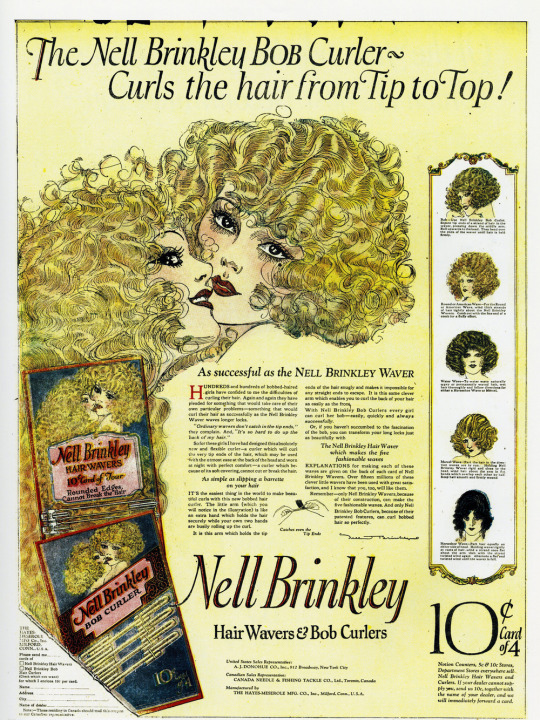
In the 1920s, her art involved sequential images and interesting stories, all starring young women as the main protagonists and centering their point of view. Starting with her serials in the 1910s and steadily creating comics during the rest of her career, she was an incredibly prolific author. From 1918 and onwards, most of her comics were full page and full color, a privilege reserved for very few artists during those years.
The Adventures of Prudence Prim, written by Carolyn Wells and illustrated by Brinkley, follows the life of a young lady who lives with her two sensible Edwardian aunts, and who has dreams of romance and adventures. Prudence takes the opportunity of her aunts taking a nap to go out and experiencing life for herself, after all « now if I just sit still and do exactly as I ought - I’ll never get a thrill ! » And so the adventures of Miss Pruddy Prim begin ! They are told each Sunday as she lives through new experiences and goes out and wears glamorous and fantastical ensembles. The pages are peppered with the different characters that Prudence Prim meets during her adventures, from society ladies with beautiful clothes and bobbed hair to dashing suitors who sweep her off her feet. Brinkley truly takes the time to dress all of her characters in fanciful outfits to match the universe she creates. The story is told by small, witty verses with a lot of good humor. Those narratives capture a certain desire for escape and the new daring sensibilities of young women, of their hunger for love and life. It is complete with the details of the latest fashion and decorated with illustrations of roses which will eventually influence the style of shoujo manga in the 1970s, with its abundance of roses, the drama, and extravagance of feelings.
The art of Brinkley creates a very indulgent feminine universe, where the men are dashing and noble, but still drawn in a very feminine way. It is in line with the slight gender fluidity of the time, where men were more delicate and women were cutting their hair short. Nonetheless, her worlds were utterly feminine and yet were trying to change what this world meant for the young woman of the interwar period — to leave the past behind and move toward the future and document the rapid changing social norms for women. Her style is especially striking in its transitional quality between art — the heavily ornamented and rounded lines of the Art Nouveau years in which she came of age and the streamlined and fashionable lines of Art Déco. It is a style that found a lot of admirers, but also a lot of detractors. She truly made her signature style one that captured the new woman of the era. She captured a very specific moment in time and the way women might have understood themselves. This understanding was not universal, however it captured the way American women wanted to visualize themselves. The way they wanted to represent and depict their future. It was an ideation that was becoming reality. In a way, Brinkley was creating the future through her art. Of course, she was not the only one. She was simply part of a moment in time, but I do have to say that Brinkley, with her frothy pictures and her fanciful curves was successful in a way a lot of artists were not.

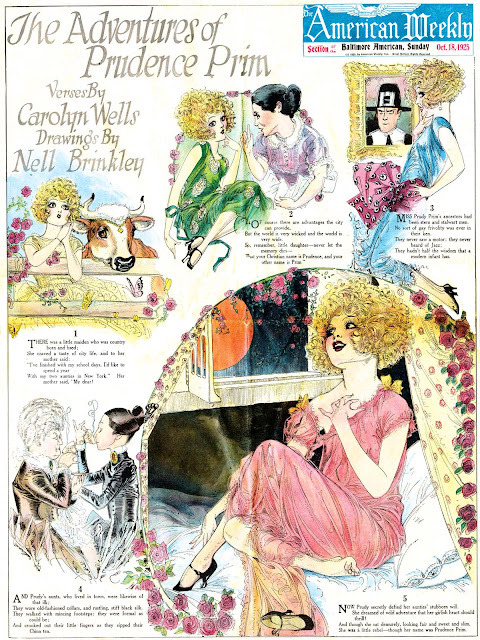
To me, she represents a very feminine idea, and to me, this type of art often receives criticism simply for daring to be feminine, maybe a bit shallow, maybe a bit superficial, but after all very cute and very fun. The rococo genre of the 18th century received similar criticisms in my opinion for being sugary and cute and overtly feminine. And this is simply always an unfair criticism to me, because judging something being aligned with femininity negatively comparatively to something more masculine is just plain old sexism. It’s not that the genre of rococo is devoid of criticism, there can be much to criticize, but people mostly bring up the fact that its frilly and pink and for some reason, that means it is not a sign of serious art. After all, this is what the neoclassical movement that followed was about. Something more visually sober, and more serious in its subject. And once again, the pendulum of taste swings.
Nell Brinkley was interesting as an artist that had this idea of the new woman being at the center of all the work she was doing. She was active during an era of profound change in the way women were perceived and perceived themselves, and whose art was something that was created solely for the modern woman. Brinkley was a daring and brave woman, with a taste for excitement and joy. She did not back down from any challenge; she flew a biplane in 1914, illustrated it, and commented on it for her audience's pleasure:« Nell Brinkley Tastes Joys of Real Freedom Soaring in Clouds ». She had adventures of her own and lived a full and brazen life. She got married to Bruce McRae II in 1920, and then she divorced him. I have to mention that he was several years younger than she was, so she was breaking boundaries in all sorts of ways,
She was a mother but also a career woman, and always followed her heart and ambitions no matter where they took her. Despite knowing a widespread cultural and financial success during her time, Nell Brinkley went the same road as many successful women artists often do, and was subsequently rapidly forgotten by history apart from the niche academics and amateurs of early 20th century comics. What she accomplished was no small feat. She managed to create this pictorial universe that understood the preoccupations of a modern woman, from her leisure to work to romance, from her activism to her frivolities, and how to balance all of it. She was a modern woman through and through.
This archetype of the modern girl is an intrinsic part of national identity and how those identities shaped the way she was understood and the way she was perceived by the general public, not only domestically but also internationally. She was also used for pushing political agendas either as to how the youth, and especially young women, were out of control, and trying to reassert the previous order of things, were women were not going out partying at all hours of days, and were expected to stay home. Or, on the flipside, using those young women living their lives as a political statement about how much more modern and civilized she was compared to the quote unquote retrograde societies and traditions. And this happened not only in the western world, but in Russia, India, China, Japan and elsewhere. From the illustrations and caricatures of Guo Jianying who satirized this new type of modern woman in China, with jokes and piques about the way things were changing, and changing fast, to the ads in various news papers across the world that promised their customers beauty and pleasure.
During the interwar, the illustrated advertisements for the brand Shiseido, a brand that started in 1872 and still is a sizable part of the beauty landscape today, and that revolutionized the market for the modern woman in Japan, were at the intersection of art, design and advertisement. These images were ones that were communicating an idea of modernity and newness, and yet advertised products that helped the consumer access this new ideal and be able to adhere to the beauty standards of the era, that were particular to Japan.

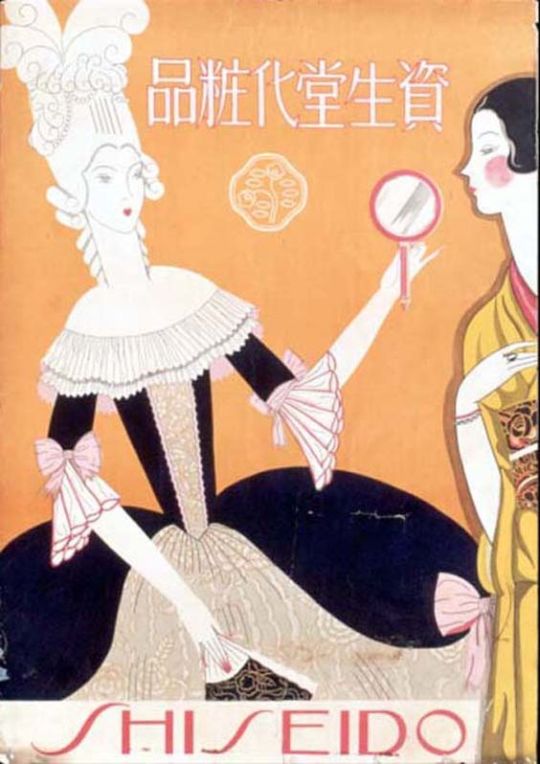
Shiseido’s graphic design communicated an idea of chic elegance that was becoming an aspirational quality during the interwar. The poster design by Sawa Reika in 1927 shows a young blonde woman wearing a fashionable evening dress holding a camelia flower, the brand’s logo, which was designed by Yabe Sue in 1924, all with the streamlined aesthetic conventions of art deco, and a limited palette of colors The result is minimalist and beautiful, and conveys so efficiently this new type of lifestyle and modernity that was being created, all through the use of graphic designs and cosmetics advertisements.
Even though the concept itself the of womanhood during the interwar was a mix of effervescence in the way it developed and grew and changed, and how, it stayed the same in a lot of ways. The illustrations of journals and magazine covers such the covers of the german graphic design journal « die reklame » in 1929 by Albert Rabenbauer were just another way the image of the modern woman got used in the art and the advertisements, not only helping to construct the idea of a modern woman, but the way that cosmopolitanism and the life in the urbane centers, full of the busy bustle of cities is just another way young women could enjoy a certain anonymity and freedom.
The idea of a chic and cosmopolitan world of material goods, of parties, of champagne and music, of a worldly but extremely fun woman at the center of it was one that was dominating the imagination. Ethel hays had small comic illustrations in the papers that satirized and caricatured that specific archetype of the flapper. Her character « Flapper Fanny » was the woman who was fashionable, a bit silly and yet, still very witty. Hays’ illustrations are extremely adorable, and manage to land a joke or a line with only a small drawing. The modern woman, the flapper, the gamine, this idea of the intrepid fashionable new woman was constructing itself in reality and also through the art, the illustrations and the visual representations of her in the advertisements and those, in turn, helped shape the way that the modern woman saw herself. Despite what she represented about this new era, being used to express concepts of modernity, a fear of change when women are going out and gaining those newfound freedom, being bolder and more in touch with their sexualities and their expanding idea of femininity, these women were still people and not only concepts about which people could discourse and debate, and I think this is something that is quite often forgotten.



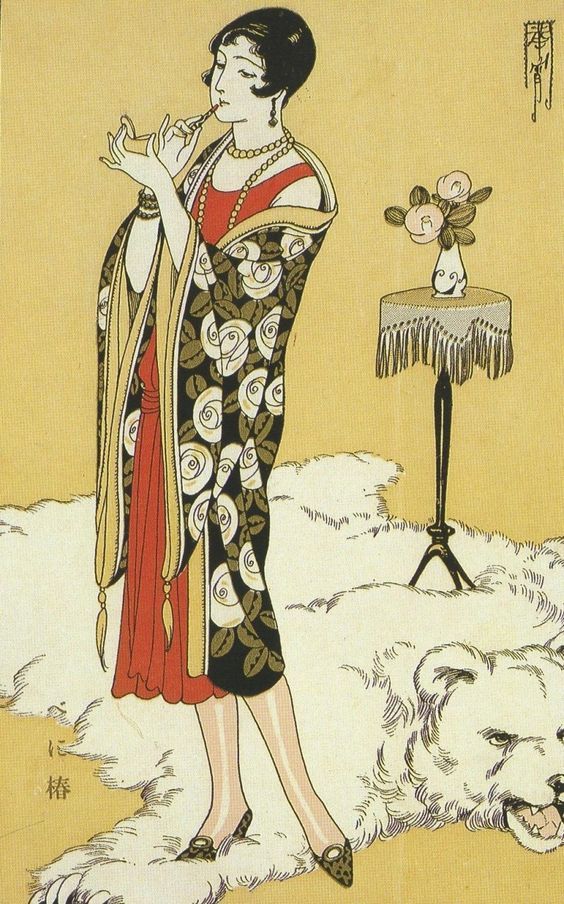

13 notes
·
View notes
Text
Good morning dash! (see, I told you I'd talk to you soon)
Today's the day, the sun is shining, the tank is clean! (don't panic we wanted the tank clean this time) I will be posting the complete follow list here in the next hour or two, and when I do, our doors will be open once again!
So... What does this mean for you?
Your characters have won a shiny new home! No more living in the Hotel, they all have houses now.
The location blog will go further into detail in the coming weeks, but homes of all sizes and types will be available, so the only limit is your character's imagination.
To the north of town will be more modern homes and our more upscale shopping. Meraki station is located here, so if you plan to travel frequently, you should accustom yourself with this area.
To the east, we have a more Victorian and Edwardian style residential area along with smaller shops and a cozy down town area.
To the west, we have mid century architecture, along with many dining and communal areas.
To the south, we have lower income housing, apartments, townhouses, etc... along with a rich natural area. Please be wary of the forest and the waters in this area after dark. Cryptids aren't cryptic in the safety of Evergreen.
All other important information will be coming soon. Please take the next few days to make yourself at home.

7 notes
·
View notes
Text
Friday: Historical AU
The last day of @order63!!! I've gone for an Edwardian AU, now posted on AO3 here, complete with appendix of research notes. Initially this started out as an excuse to write about codywan in very nice Edwardian dresses, and then it became about Jewish history and Moorish style architecture. Rated T and about 1.5k words. Happy late birthday and early Hanukkah to @goddammitjim <3
33 notes
·
View notes